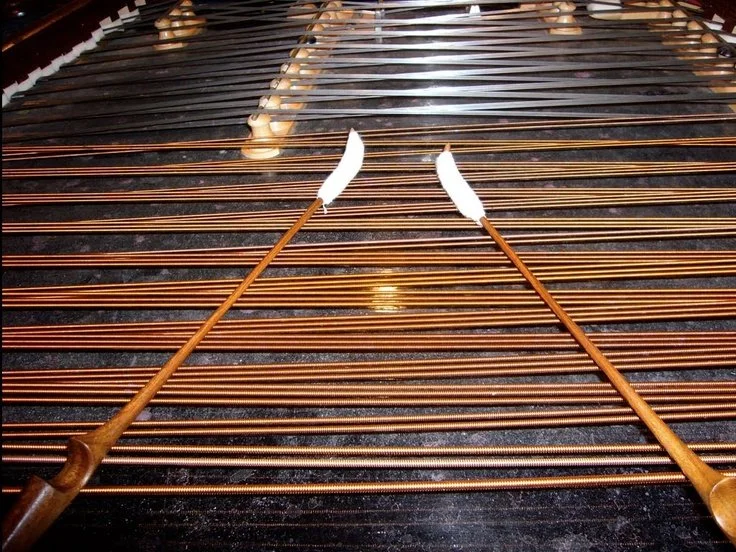Stefan Banic was a Slovak inventor who constructed a prototype of a parachute in 1913 and tested it in Washington D.C. in front of the U.S. Patent Office and military representatives by jumping from a 41-floor building and subsequently from an airplane in 1914. When no one was interested in buying his invention, Mr. Banic donated his patent to the United States Army Balloon Corps, in return for which the Army made him an honorary officer, even though he never could obtain United States citizenship. His patented parachute became standard equipment for U.S. pilots during the First World War.
Strings of Heritage: Exploring the Cimbalom
The cimbalom is a unique instrument hailing from Slovak history. It is played by felt mallets, similar to drum sticks, which are hit against piano-like strings. A variety of sounds can be produced by the cimbalom, ranging from rolls to glissandos to staccatos. From the Byzantine era to the modern day, the cimbalom is an underrated, yet appreciated and distinguished instrument.
Alfons Mucha: Father of Art Nouveau and Proud Czech
Alfons Mucha was an illustrator and the originator of the Art Nouveau movement. After being expelled from school for doing poorly, he decided to become a professional artist but still had trouble getting accepted by the Acadamy of Fine Arts in Prague, meaning he had to begin with a modest career. With the aid of a wealthy benefactor, Mucha worked as an illustrator in Paris, where he found his first lucky break when being commissioned to work on the commercial advertisement of Sarah Bernhardt’s Gismonda. This was the moment when his career prospects and celebrity skyrocketed.
July 5: Day of Saints Cyril and Methodius
Saints Cyril and Methodius have shaped the history of Christianity and even language in Eastern Europe. By translating the Holy Bible into the Slavic languages, they were able to convert many Slavs to Christianity. Their efforts have resulted in the existence of the Cyrillic Alphabet through the development of the Glagolitic Alphabet, for example. July 5 is the day when the Saints’ far-reaching efforts are recognized.
Czech Dogs and their History
The Czech Republic is home to seven different dog breeds with a storied history. The Bohemian Shepherd, for example, is the oldest breed, developed to guard the Kingdom of Bohemia. Most of these breeds were developed for rescue missions and hunting, either with a human companion or on their own. These Czech dog breeds have shaped the nation and continue to provide companionship and support to this day.
Czech Cottage Culture
The Legend of Lech, Cech, and Rus
The legend of the three brothers Lech, Cech, and Rus, who became the ancestors of the Polish, Czech, and Rus, explains how these cultures were created. The legend involves the brothers being the son of prince Pan and leaving the Pannonia empire. Some accounts don’t involve Rus, rather just Lech and Cech, who are the sons of Jan and not Pan.
Gender Roles under Communism
Under Communist leadership, Czechoslovakia held that women’s emancipation was equal access to the workforce and increased educational and social reforms, but they failed to address the issues of housework, gender roles, and women’s political presence. For example, while women were 11 times as educated in 1975 as they were in 1945, they were directed towards traditionally feminine fields of study. At the same time, however, financial and moral incentives were introduced for women to work for the bureaucracy. There’s no doubt that gender roles were becoming complex while staying traditional in Czechoslovakia.
LGBTQ+ Marriage In The Czech Republic and Slovakia
The former communist-controlled Czech Republic is now one of the most progressive countries regarding LGBTQ+ (same-sex or transgender) rights, but inequality remains. While civil unions are now recognized, same-sex marriage is illegal and is under review as of June 2023. However, the LGBTQ+ in Slovakia do not even have civil unions, let alone same-sex marriage, though there is the law of a “close person,” which is someone who is close to an individual. Just as in the Czech Republic, Slovakians are vying for same-sex marriage to be legalized.
George "Papa Bear" Halas
The Chicago Bears began with American football coach, owner, and NFL administrator George “Papa Bear” Halas, born in Chicago, Illinois to Slovak immigrants. Initially, however, Halas began as a player who joined the Navy during World War I, before becoming a player-coach. Throughout his life, “Papa Bear” Halas invested his life into football, winning six NFL championships as head coach while practicing many innovative routines that allowed him and his team to win.
Great Moravia: Svatopluk I and Mojmir II (870-907)
The story of Great Moravia continues with the arrest of Svatopluk I's arrest. Becuase of Svatopluk's supposed death, the Moravians, in anger, elected Slavomir in his place until Svatopluk came back. After the death of Svatopluk II, his son Mojmir II took his place, after which the kingdom saw some hard times, including wars.
National Uprising Day
Great Moravia: Mojmir I and Rostislav (830-870)
After the death of Samo, there was uncertainty about the Czech and Moravian lands, but after the rise of Charlamange of the Frankish Kingdom, Moravians were able to recover. The princes of Moravia consolidated their power, and one in particular Mojmir I, rose beyond tribal institutions to establish Great Moravia. After Mojmir I's deposition, his nephew Rostislav became Louis the German's loyal vassal. In secret, however, Rostislav had ambitions beyond this.
Samo and his Empire (631 – 658)
In the mid-seventh century, the "first Slavic State" came into existence, ruled by Samo, thus named Samo's Empire. It began with Samo as a Frankish merchant who aided the Slavs in their revolt against the ruling Avars. Samo was such a major contributor to the effort that he was chosen as the leader. The rest is history...
Assassination of Reinhard Heydrich
"The Butcher of Prague" Reinhard Heydrich established himself as a ruthless authority among the Nazis, terrorizing Eastern Europe. Czechoslovakian president Eduardo Bene ordered a team of assassins to kill Heydrich. These assassins were Josef Gabcik, a former blacksmith and locksmith, and Jan Kubis, both of whom rose up the ranks in the Czech military. Of course there were others, 7, in fact, and if they were successful is written.
The Czech Flag: A Century of Waving
Inspired by the American holiday, many nations in the world celebrate Flag Day, including Czechia. Before Czechia, there was Czechoslovakia, whose flag, created in 1918, featured 2 horizontal stripes, white on the top and red on the bottom. The flag changed to include a blue wedge from the left and has remained this way since, including after the separation of Czechoslovakia into the Czech Republic and Slovakia.
Mother's Day in Czechia: Charlotte Masaryk
Through history, celebrating Mother’s Day in the Czech Republic was more complicated than one could imagine. It begins with the wife of Tomas Masaryk, Charlotte, who fought for women’s rights and taught her daughter, Alice Masarykova, to do the same. After her mother’s death, Alice established Mother’s Day in 1923. The complications of Mother’s Day lasted for a long time, into Czechoslovakia’s Communist occupation.
Rock Music in Czechoslovakia
The history on rock music in Czechoslovakia begins with its introduction in the early 1950s, beginning apolitically. By 1968, the apolitical aspect changed, in response to the 1968 Soviet bloc invasion, causing rock music to finally rebel and criticize the government, through satire and cryptic messaging, as the lyrics and content of rock songs were monitored.
Andy Warhol
Věra Čáslavská: Athlete and Activist
Athletes have long been using their high-visibility platforms to comment on social issues and raise awareness. Věra Čáslavská, a gymnast from the now Czech Republic, is not only famous for her unparalleled success at the Olympic Games but her strong stance against the Soviet invasion of her country.



















